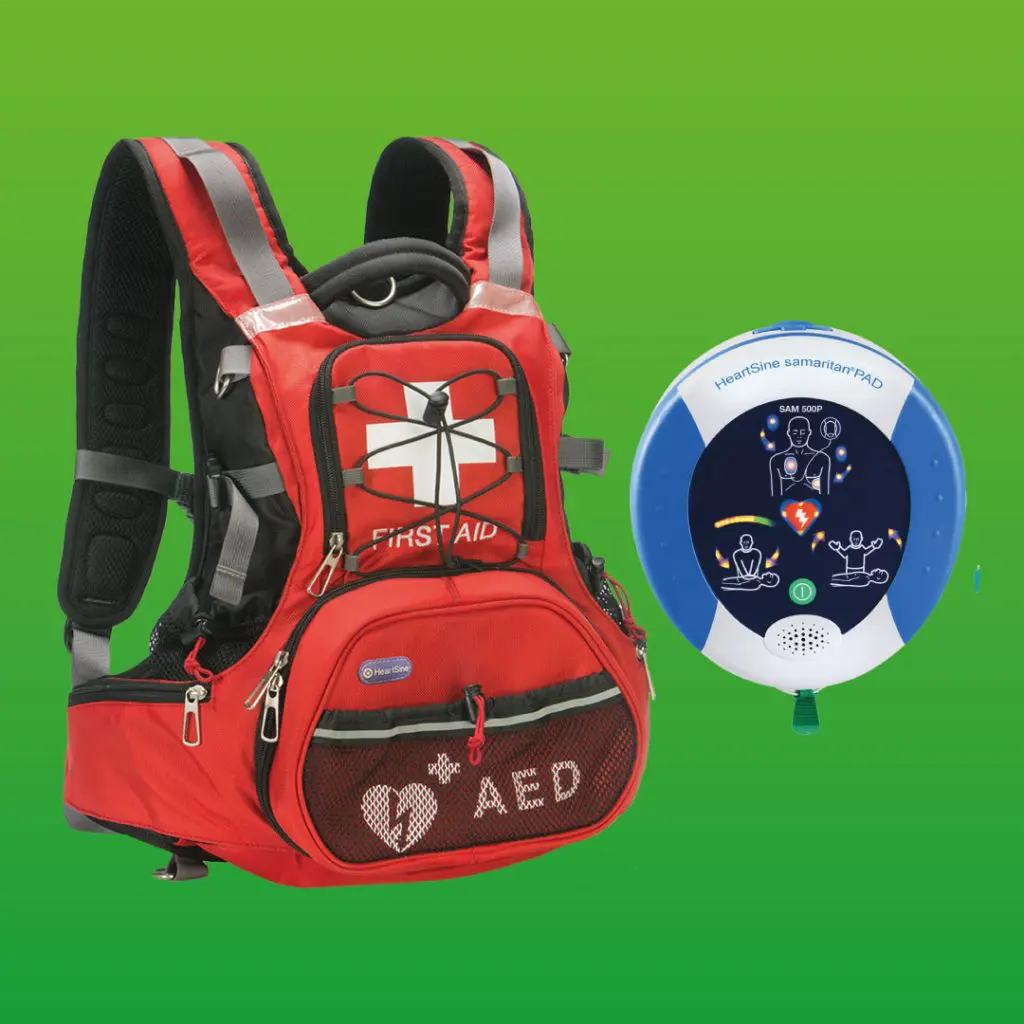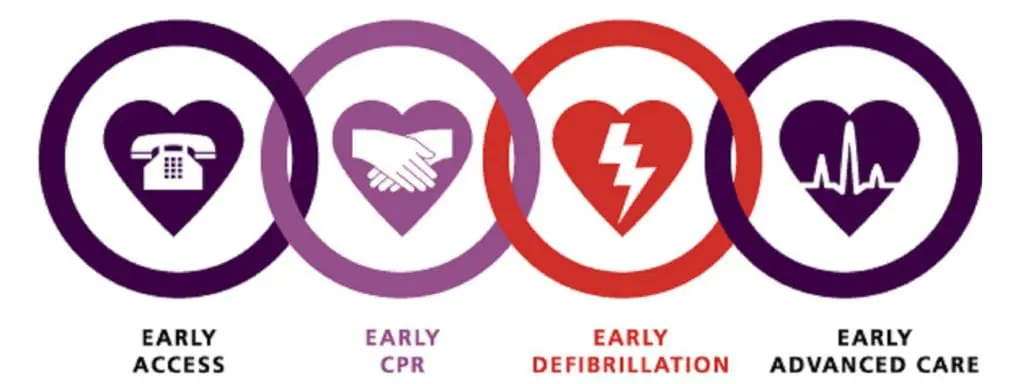
HeartSafe Frequently Asked Questions
If your community does not have quick and easy access to a defibrillator, a life could be lost unnecessarily. Don’t delay, follow the HeartSafe® initiative and protect your family and friends.
What is a sudden Cardiac Arrest?
Sudden cardiac arrest (SCA) is a leading cause of premature death, but with immediate treatment many lives can be saved. SCA occurs because the electrical rhythm that controls the heart is replaced by a chaotic disorganised electrical rhythm called ventricular fibrillation (VF). The quicker VF can be treated by defibrillation the greater the chance of successful resuscitation. Seconds count and the ambulance service is unlikely to arrive quickly enough to resuscitate most victims.
When does a sudden Cardiac Arrest strike?
Sudden cardiac arrest can occur at any time to anyone, of any age. It can occur suddenly, without warning. Research shows that SCAs outside of hospitals are most likely to occur in your home between midnight at 7 am. It is unpredictable. Following SCA the patient’s survival rate drops by 10% every minute without treatment to maintain blood circulation. In the UK, less than 5% of victims survive out of the hospital. Together with cardiopulmonary resuscitation (CPR), defibrillation is the only way to re-establish the heart’s natural rhythm. This can only be done by early use of an AED and effective quality CPR.
There is a correlation that the likelihood of SCA increases with extreme weather temperature changes. Statistical evidence proves that in cold weather there is more likelihood of SCA occurring. All sports including contact sports may place people at a higher risk of SCA.
What are the facts about Sudden Cardiac Arrest?
Sudden Cardiac Arrest (SCA) is the single most significant cause of death – around 100,000 deaths per year are as a result of SCA. It is estimated 60,000 occur out of hospital. Less than 5% of sufferers survive a cardiac arrest. With the early use of an Automated External Defibrillator (AED) and effective CPR, the survival rate can increase to 50%. There is a likelihood that cardiac arrests will occur within the population of one of our business/projects whilst workmen, professionals or visitors are on the premises/site.
Many SCA victims can be saved if persons nearby recognise what has happened, summon the ambulance service with the minimum of delay, perform basic cardiopulmonary resuscitation (particularly chest compressions) and use an AED to provide a high energy electric shock to restore the heart’s normal rhythm. Each of these stages is a link in a chain of events that provide the best chance of success, but the critical factor is the speed with which the shock is given.
What is an Automated External Defibrillator (AED)?
An AED is easy to use, compact, portable and very effective. They are designed to be used by laypersons; the device guides the operator through the process by verbal instructions and visual prompts. They are safe and will not allow a shock to be given unless the heart’s rhythm requires it. They are designed to be stored for long periods without use and require very little routine maintenance. Several models are available from the manufacturers or through medical equipment companies.
HeartSafe® recommend a British manufactured defibrillator, the HeartSine samaritan range. Click here to watch how a HeartSine AED is used in an emergency.
What are the features of an AED?
Defibrillators are manufactured in various countries around the world. It is important before a purchase is made that the defibrillator you choose conforms to the MDR Regulations. In May 2020 the MDR Regulations were due to take place however due to Covid-19 this has been postponed by 12 months. Always check with your supplier that your defibrillator is fit for the purpose for the period of warranty. Like with any medical product, there can be recalls and model changes.
Defibrillators have different features and warranty periods vary between 5-10 years. Be aware of the ongoing consumable costs which include the replacement of electro-pads and batteries. Be aware of any monitoring/maintenance requirements. Some defibrillators are able to record events, which can vary from 30 minutes to 90 minutes. Be aware of the expiry date of consumables. Electro-pads and batteries may expire at different dates between 2-5 years.
HeartSafe® AED Locator after research has chosen to recommend a British manufactured defibrillator, the HeartSine range. The 3 models 500P, 350P and 360P offer differing operational features but all have a 10-year warranty, exceptional low cost of operating with a free consumable offer for the 10 years of warranty along with a simple monitoring/maintenance program. Above all, it is having confidence in the defibrillator you choose. It will need to help you with the minimum of fuss and assist in the chain of survival when CPR is administered.
The early use of a defibrillator with effective quality CPR within a few minutes of a victim suffering a SCA can increase the odds of survival of the patient. Without the use of a defibrillator and CPR, the patient’s chances of survival are less than 5%. The use of a defibrillator and quality CPR within 3-4 minutes of the arrest occurring can increase the odds of success to 50-70%.
Purchasing a defibrillator can be confusing, as the technical ability and performance of the defibrillator may be only understood by trained personnel and salespersons! When in doubt, before the money is spent, we recommend you discuss with us your specific requirements of where your defibrillator is to be positioned and who it is likely to be used by. We will be happy to give you our advice before you commit to any purchase. Contact Us
How does an AED work?
A defibrillator, whether it is semi or fully automatic is designed to quickly deliver a defibrillation shock to victims of sudden cardiac arrest (SCA). Once the electro pads are placed on the victim’s chest, the defibrillator analyses the patient, looking for a shockable arrhythmia (bad heart rhythm). The defibrillator cannot be used incorrectly as it will only deliver a shock to the patient if it detects it is necessary. The electrical shock when administered is to re-establish normal heart rhythm. This treatment is called “defibrillation”. The use of an AED is part of the chain of survival.
Who can use an AED?
AEDs have been installed in many busy public places, workplaces, sports centres, schools and communities. Any location where the Emergency Services may be delayed, particularly remote country areas are the locations to be considered. The intention is to have quick access to the defibrillator and use the device to restart the heart as soon as possible. This strategy of placing AEDs in locations where they are used by laypersons near the arrest is known as public access defibrillation (PAD). HeartSafe® AED Locator is proud of its heritage over the last 12 years. It was the first organisation to place AEDs in public locations, supported by the Ambulance Trust. A pilot scheme in the Chew Valley area, west of Bristol Airport positioned 15 AEDs in purpose-built, designed secure cabinets. Awareness training was given to 15 Villages supported by Great Western Ambulance Service (now SWAST). To date, many thousands of cabinets have been located throughout the UK. The use of an AED is an extension of the first aid skills possessed by first aid personnel and other appointed persons.
However, HeartSafe’s continual efforts in making the use of defibrillators public to all have successfully allowed untrained persons who lack any medical skills to use the defibrillator in an emergency. It is for this reason that the HeartSine range of defibrillators has been chosen as it helps to ensure the layperson is guided through the CPR process and is encouraged to perform chest compressions of high quality. The device will provide you with spontaneous verbal feedback. The device has a 90-minute memory recording of the event and where multiple samaritans assist in giving CPR, each person is brought up to a quality level of CPR when following the feedback the device gives. HeartSafe® AED Locator encourages anyone to have a go and use a public access defibrillator when a person has suffered a sudden cardiac arrest. When the victim shows that they are unresponsive/not breathing, an SCA may have occurred and the chain of survival should be followed.
- Call 999
- Start CPR
- Switch on defibrillator
- Follow its instructions
What is the "Chain of Survival" and what are the four links of the “Chain of Survival”?
The Chain of Survival is the series of actions necessary to help save the life of someone who has had a cardiac arrest. The four actions in the Chain are early recognition of the problem and calling 999; early CPR; early defibrillation; and effective post-resuscitation care. All four parts of the Chain are crucial in helping to save the life of a victim. See link to Chain of Survival (British Heart Foundation) for more information click here.

Legal Requirements
In the United Kingdom, there are very few legal barriers to public access defibrillators. A rescuer who has acted appropriately to help a victim of SCA should not be sued regardless of the outcome. Defibrillators are manufactured for public use. It is of course helpful if the person using the AED has knowledge of the chain of survival. However, the defibrillator is made for people with little or no training as well as trained personnel. When the device is switched on it will give verbal instructions for use. The HeartSine samaritan® PAD 500P speaks more and gives accurate feedback to rescuers on the effectiveness of the CPR they are providing to the victim. Recent successful “lives saved” using the 500P have even reported where 5 rescuers (Policemen) took in turn over 26 minutes before the paramedics were able to arrive, provided quality CPR ensuring the brain was not starved of oxygen due to the effectiveness of the feedback given by the device. The rescuers continued to push much harder and much faster than they thought possible. This led to a full recovery of the victim. This is just one of many cases where the feedback to the rescuers made all the difference to the survival of the victim.

